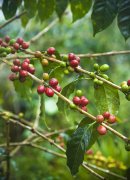Ethiopian Sunshine Sidama Coffee Flavor and Taste introduction to Sidamo producing area
Gima, which accounts for about 50 per cent of Ethiopia's annual output, grows between 4400 and 6000 feet above sea level in the country's southwestern highlands (the border between Kaffa and Illubabor provinces) and is usually exported to G5/G4.
However, in recent years, about 10% or 20% of Gima has been used to make up for the lack of taste of coffee, but its quality has gradually declined to its own level, but there are bipolar comments on coffee buyers (my friend only uses Gima as the base of espresso in his store, and its strong flavor surprises me). The coffee is like a hara, which follows the ancient method of sunbathing. It is also a little sour but slightly inferior to Hara, with medium texture and rugged earthy taste.
Ghimbi & # 39; Lekenpuri (Lekempti)
Growing in western Ethiopia, 4900-5900 feet (Wollega province) plateau, north of Jima, mostly wild, annual output is about 500000bags/60kg, export is mostly G5/G4, bean body is larger and longer than Longberry, a little brown in green, taste similar to less jasmine tea, more bitter, lack of rising Hara, slightly sour, slightly fruity and wine aroma, but slightly inferior to Hara, but with good texture and viscosity. So the beans in Jinbi District are jokingly called "poorman'". SHarar ".
The taste is complex but balanced, with better throat rhyme in deep culture and longer back sweet, which is one of the materials that many bakers like to use as comprehensive beans, of course, it can also be used as a good single product, suitable for drinking after meals.
Lim (Limu)
Growing in the western highlands of southern Ethiopia (the border between Shewa and Sidmo), east of Jima, north of Sidamo, most Europeans and Americans prefer 3600-6200 feet above sea level, most of them are washed with water, their annual output is about 110000bags/60kg, most of them are round (15/16scr), the color is green and bluish, the export is mostly G2, the taste is similar to Yegashev, but the viscosity is thin, but the fragrance of flowers and fruit are obvious. The sour taste is also softer than Yegashev, the more irritating acidity, the aftertaste is similar to the wine, and has a good and balanced quality. it is a noteworthy Ethiopian boutique coffee after Yegashev, but almost all limes are vertically integrated and exported by Ethiopian coffee organizations, so it is almost rare to see them in China.
It is heard that this kind of baking is more suitable for air flow medium baking, not suitable for deep baking, and the better flavor after baking is two to three days. In fact, the good Lim is on a par with Yegashev (this is actually a subjective consciousness of different opinions).
Important Notice :
前街咖啡 FrontStreet Coffee has moved to new addredd:
FrontStreet Coffee Address: 315,Donghua East Road,GuangZhou
Tel:020 38364473
- Prev

Guide to the matching of classic espresso
The person who translated Espresso into Kung Fu Coffee must have worked hard and knew that Espresso was second to none in the coffee world. Like Kungfu Tea, in addition to the nature of tea, there is also a sense of fighting, high-end fighting equipment, sophisticated fighting techniques, but also the ability to distinguish guests. Espresso is the soul of coffee. People call it espresso, as its name implies.
- Next

90 + flavor spectrum "Level" Gesha variety Level 195 (19) was harvested in a single producing area.
In the flavor spectrum of 90 +, there is a Level logo. It is the number after the product name mark L. For example, L12-means Level 12. The Level is probably in proportion to the price. It represents the grading model of raw beans: according to quality, quantity, production cost, 90 + based on the original excellent raw beans, continue to grade as follows: Level 7: single production area harvest. Will taste meticulous and
Related
- Guji coffee producing area of Guji, Ethiopia: Humbela, Shakiso, Wulaga
- What is the most expensive variety of Qiloso in BOP multi-variety group?
- How to store the coffee beans bought home?
- Why are Yemeni coffee beans so rare now?
- Ethiopian Sidamo all Red Fruit Sun Sun Santa Vini Coffee beans
- SOE is mostly sour? What does it mean? Is it a single bean? what's the difference between it and Italian blending?
- Is Italian coffee beans suitable for making hand-brewed coffee?
- How to choose coffee beans when making cold coffee? What kind of coffee beans are suitable for making cold coffee?
- Just entered the pit to make coffee, what kind of coffee beans should be chosen?
- Can only Japan buy real Blue Mountain Coffee? What are authentic Jamaican Blue Mountain coffee beans?

